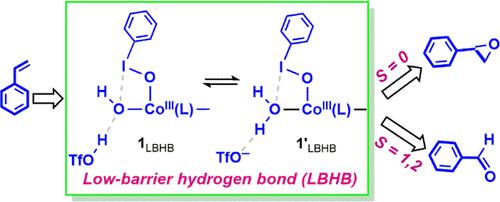当前位置:
X-MOL 学术
›
J. Am. Chem. Soc.
›
论文详情
Our official English website, www.x-mol.net, welcomes your
feedback! (Note: you will need to create a separate account there.)
Brønsted Acids Promote Olefin Oxidations by Bioinspired Nonheme CoIII(PhIO)(OH) Complexes: A Role for Low-Barrier Hydrogen Bonds
Journal of the American Chemical Society ( IF 14.4 ) Pub Date : 2023-03-03 , DOI: 10.1021/jacs.2c12307 Dongru Sun 1, 2 , Zhimin Wu 1, 2 , Xuan Zhang 1, 2 , Jindou Yang 3 , Yufen Zhao 1, 2 , Wonwoo Nam 3, 4 , Yong Wang 1, 2
Journal of the American Chemical Society ( IF 14.4 ) Pub Date : 2023-03-03 , DOI: 10.1021/jacs.2c12307 Dongru Sun 1, 2 , Zhimin Wu 1, 2 , Xuan Zhang 1, 2 , Jindou Yang 3 , Yufen Zhao 1, 2 , Wonwoo Nam 3, 4 , Yong Wang 1, 2
Affiliation

|
Introduction of Brønsted acids into biomimetic nonheme reactions promotes the oxidative ability of metal–oxygen complexes significantly. However, the molecular machinery of the promoted effects is missing. Herein, a comprehensive investigation of styrene oxidation by a cobalt(III)–iodosylbenzene complex, [(TQA)CoIII(OIPh)(OH)]2+ (1, TQA = tris(2-quinolylmethyl)amine), in the presence and absence of triflic acid (HOTf) was performed using density functional theory calculations. Results revealed for the first time that there is a low-barrier hydrogen bond (LBHB) between HOTf and the hydroxyl ligand of 1, which forms two valence-resonance structures [(TQA)CoIII(OIPh)(HO–--HOTf)]2+ (1LBHB) and [(TQA)CoIII(OIPh)(H2O--OTf–)]2+ (1′LBHB). Due to the oxo-wall, these complexes (1LBHB and 1′LBHB) cannot convert to high-valent cobalt–oxyl species. Instead, styrene oxidation by these oxidants (1LBHB and 1′LBHB) shows novel spin-state selectivity, i.e., on the ground closed-shell singlet state, styrene is oxidized to an epoxide, whereas on the excited triplet and quintet states, an aldehyde product, phenylacetaldehyde, is formed. The preferred pathway is styrene oxidation by 1′LBHB, which is initiated by a rate-limiting bond-formation-coupled electron transfer process with an energy barrier of 12.2 kcal mol–1. The nascent PhIO-styrene-radical-cation intermediate undergoes an intramolecular rearrangement to produce an aldehyde. The halogen bond between the OH–/H2O ligand and the iodine of PhIO modulates the activity of the cobalt–iodosylarene complexes 1LBHB and 1′LBHB. These new mechanistic findings enrich our knowledge of nonheme chemistry and hypervalent iodine chemistry and will play a positive role in the rational design of new catalysts.
中文翻译:

布朗斯台德酸通过仿生非血红素 CoIII(PhIO)(OH) 配合物促进烯烃氧化:低势垒氢键的作用
将布朗斯台德酸引入仿生非血红素反应中可显着促进金属-氧复合物的氧化能力。然而,缺少促进效应的分子机制。在此,对钴 (III)-碘代苯络合物 [(TQA)Co III (OIPh)(OH)] 2+ ( 1 , TQA = 三(2-喹啉甲基)胺) 氧化苯乙烯的综合研究,在存在的情况下使用密度泛函理论计算进行三氟甲磺酸 (HOTf) 的缺失。结果首次揭示HOTf与1的羟基配体之间存在低势垒氢键(LBHB) ,形成两个价共振结构[(TQA)Co III (OIPh)(HO – --HOTf) ]2+ ( 1 LBHB ) 和 [(TQA)Co III (OIPh)(H 2 O--OTf – )] 2+ ( 1' LBHB )。由于氧壁,这些配合物(1 LBHB和1' LBHB)不能转化为高价钴氧基物质。相反,这些氧化剂(1 LBHB和1' LBHB)对苯乙烯的氧化显示出新的自旋态选择性,即,在地面闭壳单线态上,苯乙烯被氧化成环氧化物,而在激发三线态和五线态上,一个形成醛产物苯乙醛。首选途径是苯乙烯氧化1' LBHB,由限速键形成耦合电子转移过程引发,能垒为 12.2 kcal mol –1。新生的 PhIO-苯乙烯-自由基-阳离子中间体经历分子内重排以产生醛。OH - /H 2 O 配体和 PhIO 的碘之间的卤素键调节钴-碘代芳烃配合物1 LBHB和1' LBHB的活性。这些新的机理发现丰富了我们对非血红素化学和高价碘化学的认识,将对新型催化剂的合理设计起到积极作用。
更新日期:2023-03-03
中文翻译:

布朗斯台德酸通过仿生非血红素 CoIII(PhIO)(OH) 配合物促进烯烃氧化:低势垒氢键的作用
将布朗斯台德酸引入仿生非血红素反应中可显着促进金属-氧复合物的氧化能力。然而,缺少促进效应的分子机制。在此,对钴 (III)-碘代苯络合物 [(TQA)Co III (OIPh)(OH)] 2+ ( 1 , TQA = 三(2-喹啉甲基)胺) 氧化苯乙烯的综合研究,在存在的情况下使用密度泛函理论计算进行三氟甲磺酸 (HOTf) 的缺失。结果首次揭示HOTf与1的羟基配体之间存在低势垒氢键(LBHB) ,形成两个价共振结构[(TQA)Co III (OIPh)(HO – --HOTf) ]2+ ( 1 LBHB ) 和 [(TQA)Co III (OIPh)(H 2 O--OTf – )] 2+ ( 1' LBHB )。由于氧壁,这些配合物(1 LBHB和1' LBHB)不能转化为高价钴氧基物质。相反,这些氧化剂(1 LBHB和1' LBHB)对苯乙烯的氧化显示出新的自旋态选择性,即,在地面闭壳单线态上,苯乙烯被氧化成环氧化物,而在激发三线态和五线态上,一个形成醛产物苯乙醛。首选途径是苯乙烯氧化1' LBHB,由限速键形成耦合电子转移过程引发,能垒为 12.2 kcal mol –1。新生的 PhIO-苯乙烯-自由基-阳离子中间体经历分子内重排以产生醛。OH - /H 2 O 配体和 PhIO 的碘之间的卤素键调节钴-碘代芳烃配合物1 LBHB和1' LBHB的活性。这些新的机理发现丰富了我们对非血红素化学和高价碘化学的认识,将对新型催化剂的合理设计起到积极作用。

































 京公网安备 11010802027423号
京公网安备 11010802027423号